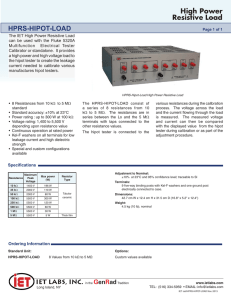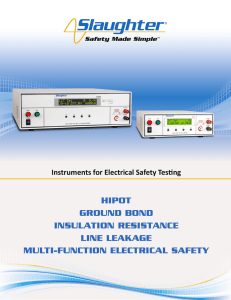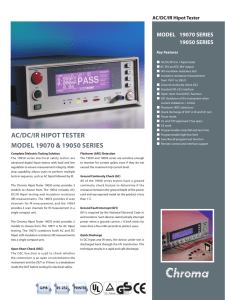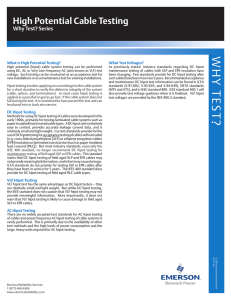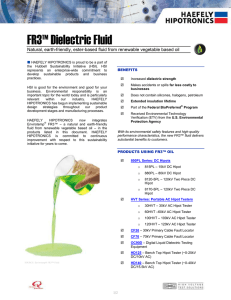500 VA Testing with the Slaughter 2525
advertisement
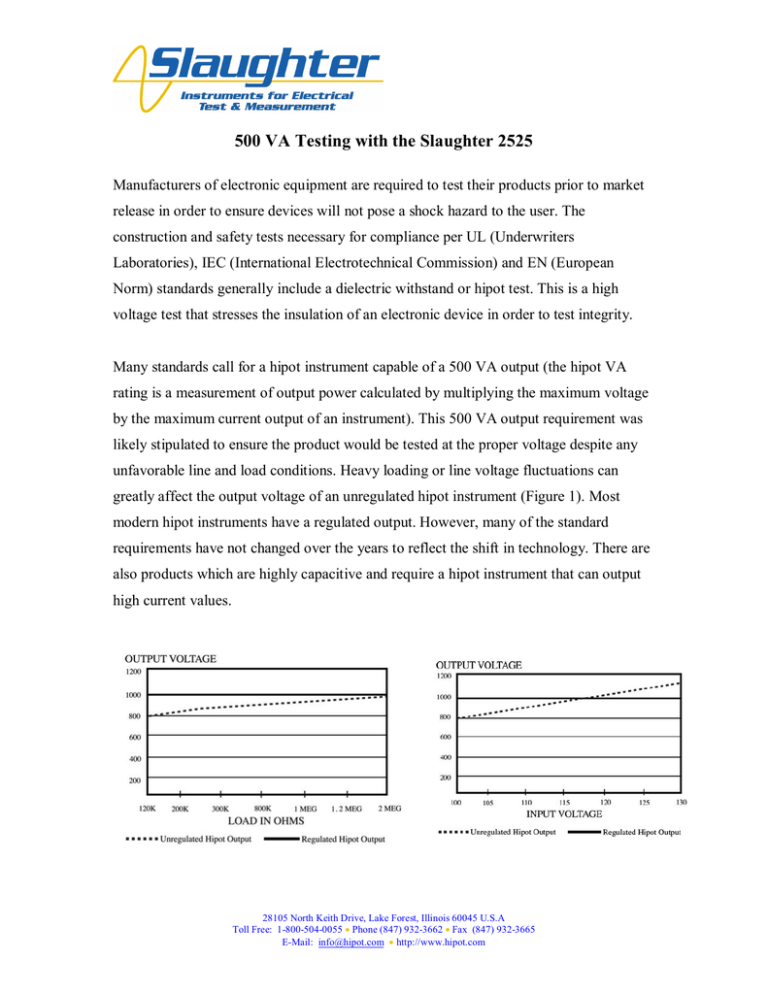
500 VA Testing with the Slaughter 2525 Manufacturers of electronic equipment are required to test their products prior to market release in order to ensure devices will not pose a shock hazard to the user. The construction and safety tests necessary for compliance per UL (Underwriters Laboratories), IEC (International Electrotechnical Commission) and EN (European Norm) standards generally include a dielectric withstand or hipot test. This is a high voltage test that stresses the insulation of an electronic device in order to test integrity. Many standards call for a hipot instrument capable of a 500 VA output (the hipot VA rating is a measurement of output power calculated by multiplying the maximum voltage by the maximum current output of an instrument). This 500 VA output requirement was likely stipulated to ensure the product would be tested at the proper voltage despite any unfavorable line and load conditions. Heavy loading or line voltage fluctuations can greatly affect the output voltage of an unregulated hipot instrument (Figure 1). Most modern hipot instruments have a regulated output. However, many of the standard requirements have not changed over the years to reflect the shift in technology. There are also products which are highly capacitive and require a hipot instrument that can output high current values. 28105 North Keith Drive, Lake Forest, Illinois 60045 U.S.A Toll Free: 1-800-504-0055 • Phone (847) 932-3662 • Fax (847) 932-3665 E-Mail: info@hipot.com • http://www.hipot.com Figure 1: Line and Load Regulation High Potential to Test Integrity The hipot test is an electrical safety test designed to stress the insulation of a device beyond what it will encounter during normal operation. The supporting logic behind this test is that if the insulation can withstand the application of high potential for a short period of time, it will be able to operate throughout its lifecycle without posing a shock hazard to the user. When running a hipot test, high voltage is applied to the mains conductors and the return point of the circuit is connected to the chassis or protective ground component (Figure 2). The resulting current that flows through and on the surface of the insulation is known as leakage current. Figure 2: Hipot Tester Connected to Device Under Test (DUT) Running a hipot test essentially creates a capacitor and the hipot instrument measures the current flowing through the insulating layer in the capacitor. Running an AC hipot test then means that there will be three current components in the hipot circuit: real current (attributed to the resistive elements in the circuit), reactive current (attributed to the capacitive elements in the circuit) and total current. Figure 3 illustrates the relationship between real, reactive and total current. 28105 North Keith Drive, Lake Forest, Illinois 60045 U.S.A Toll Free: 1-800-504-0055 • Phone (847) 932-3662 • Fax (847) 932-3665 E-Mail: info@hipot.com • http://www.hipot.com Figure 3: Vector Sum Relationship of Capacitive Current and Resistive Current The vast majority of the leakage current is attributed to the capacitive element in the circuit. This makes sense since, as mentioned prior; the hipot test creates a capacitor by the nature of the test itself. 500VA Applications A hipot instrument’s output is rated in VA (Volt Amps). Multiplying the maximum output voltage by the maximum trip current capability gives the VA rating of the hipot tester. A hipot unit capable of outputting 5000 VAC with a maximum trip current capability of 100 mA is a 500 VA rated hipot unit (5000 V * 0.1 A = 500 VA). The 500 VA rated hipot tester is utilized due to a couple stipulations: application driven and standard driven. Often times, an application contains a requirement for a 500VA rated hipot unit because it is dictated by the UL, IEC or EN standard. IEC 60335-1 illustrates this requirement in the table below: 28105 North Keith Drive, Lake Forest, Illinois 60045 U.S.A Toll Free: 1-800-504-0055 • Phone (847) 932-3662 • Fax (847) 932-3665 E-Mail: info@hipot.com • http://www.hipot.com Test Voltage Minimum Current V mA Is Ir <4000 200 100 4000 and <10,000 80 40 10,000 and 20,000 40 20 IEC 60335-1 Table 5: Characteristics of High Voltage Sources In the table above, Is represents the short circuit current capability of the transformer and Ir is the minimum required trip level of the instrument. These two numbers are common across a variety of standards (Table 2). Standard/Harmonized Standard Product IEC/UL 60335-1 Household Electrical Appliances UL 60745-1 Hand-Held Motor-Operated Electrical Tools IEC/UL 60065 Audio, Video and Similar Electronic Apparatus UL 2158 Electric Clothes Dryers Table 1: Standards requiring a 500 VA hipot instrument Standards for other products may not necessarily require a 500 VA hipot unit. However, due to the nature of the product, a greater mA leakage current trip capability is necessary to properly test products. For example, large motors and long spools of cable tend to represent highly capacitive loads when hipot tested. As a result, a hipot with a higher minimum trip current is necessary to receive leakage current readings. 28105 North Keith Drive, Lake Forest, Illinois 60045 U.S.A Toll Free: 1-800-504-0055 • Phone (847) 932-3662 • Fax (847) 932-3665 E-Mail: info@hipot.com • http://www.hipot.com The 2525: Meeting 500 VA Requirements Whether a product standard calls for a 500 VA hipot unit or a manufacturer is dealing with a capacitive product that exceeds most hipot instrument’s capabilities, the Slaughter 2525 AC hipot tester meets these testing requirements. The 2525 is a 500 VA (5 kV, 100 mAAC) rated, CE and TUV listed hipot instrument. Slaughter 2525 Hipot Tester The 2525 instrument’s voltage regulation circuitry ensures that the output voltage will not dip under any line or load conditions. Additionally, the 2525 meets the 200 mA short circuit current requirement called out in various product safety standards. These features, along with an intuitive user interface, make the Slaughter 2525 a versatile yet simple hipot instrument. Conclusion Recent technology trends for hipot testing equipment are shifting towards hipot units with a regulated output. Many safety standards, however, still require 500 VA output for high voltage equipment. Specific applications may also affect a manufacturer’s choice in a hipot instrument as their product may be highly capacitive. As a result there is still a strong need in the market for a hipot unit with 500 VA output capability. The Slaughter Company is able to meet these hipot testing requirements by offering the 2525 instrument at a competitive price. 28105 North Keith Drive, Lake Forest, Illinois 60045 U.S.A Toll Free: 1-800-504-0055 • Phone (847) 932-3662 • Fax (847) 932-3665 E-Mail: info@hipot.com • http://www.hipot.com
